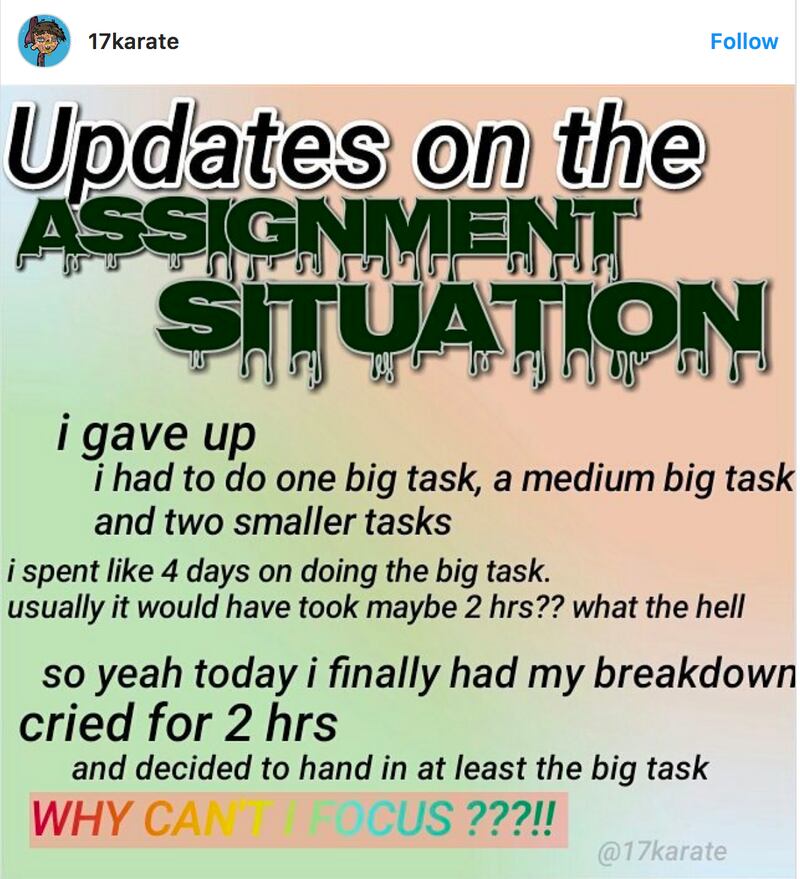Almost every day, while she’s waiting for soccer practice to begin or for her mom to pick her up from school, 14-year-old New Yorker Carly* fires up her phone and vents about her day to 150 anonymous strangers on Instagram, the only group of people who she feels truly understand her.
Her emotional outpourings aren’t posted to a finsta, spam account, rinsta, or any number of other types of Instagram accounts most kids maintain. Instead, she shares these pink and yellow diatribes to a dedicated niche meme account.
Niche memes are easy to spot with their bright pastel backgrounds, large cartoony typefaces, and scattered cut outs and clip art. If you follow teen girls on Instagram, you’ve undoubtedly seen the format seeping into your Explore page over the past couple months.
These memes represent a new way young teen girls are connecting with each other online and provide a lifeline for kids who feel like no one understands them. The accounts are Gen-Z’s version of a LiveJournal.
Though there are hundreds of thousands of niche memes on Instagram, each creation is a unique, hyper-specific collage about the creator. They’ll reveal something like “What happened at volleyball tryouts today,” “Why I didn’t try out for swim team,” “Tour of my block E Spanish class,” or “Stuff I really want for Christmas this year.”

At first glance, niche memes look like pastel and neon-soaked starter packs. They generally have big text up top, followed by a grouping of cut-out images with interspersed text. But unlike starter packs, they aren’t supposed to speak to a specific “type” of person or experience as much as one particular person or experience.
Each account has its own cohesive color scheme and a stock image or cartoon avatar, usually from a retro TV show like Arthur or Sailor Moon. Often, kids include their zodiac sign in their bio or username. Young girls use their niche meme accounts to follow other meme and niche meme accounts, rarely friends from school.
Glancing through a niche meme account can feel a lot like reading a diary. The “memes” are a mix of personal stories, recaps of text message conversations, collages detailing the subtleties of social dynamics in middle school, and vision boards outlining big aspirations—or just things the owner wants to buy at the mall.
“Niche memes are memes that are supposed to be relatable to you only,” said Katie, a 13-year-old in Ohio who niche memes under @yosemitememes. “They have to be specific to your life exactly, not like, a general thing.”
Unlike standard meme accounts, niche meme accounts aren’t supposed to make the average person feel “heard.” Their power comes from each meme’s tiny audience—that they’re only really understood by a small “niche” group of people.
When young women post about their hyper-specific experiences online via niche meme accounts they’re doing it because they hope that someone somewhere will understand and relate to them. It’s about finding “your people” on the massive sea of Instagram.
“If you tried to explain this hyper-specific topic or thing that happened in real life people would be like, ‘Uh, what are you talking about?’” said Jen, a 15-year-old in Nevada who niche memes under the account @memegazette. “But if you put it in your niche meme page people can be like, ‘Oh, I have someone like that at my school too.’ The humor behind it is because it’s so hyper-specific that when you do find a niche meme that you relate to, you feel like, ‘Wow somebody out there understands.’ You can laugh about it.”
“When I see posts of mine that a large number of people interact with I feel more validated in my wants or experiences because I know I’m not alone,” said Julie, a 14-year-old who runs the niche meme account @2007britneyy. “I’ll get messages like ‘this reminds me of myself!’ It’s a little weird that so many people care about what someone’s wearing or their recent shopping trip, but it’s a fun outlet to talk about it and I find people with shared experiences or interests.”

While the majority of niche memes are so specific that most followers won’t relate, they’re still compelling to consume as entertainment says Sally, a 20-year-old who posts niche memes under the account @TiddyGorl.
“It’s like a peek into someone’s life,” she said, comparing it to watching a vlog. “You get to see what their life is like, what they’re wearing, doing, thinking, what their opinions are. Everyone wants to know what’s going on in other people’s lives on the internet.”
The desire to learn about and connect with new people is also why Terry, a 15-year-old niche memer under the name @strawberrytints said she started her account.
“Honestly it’s a great way to meet other people,” she said. “You learn a lot about them for example how they define themselves and their mindsets, it’s fascinating.”
You’ll never see screenshots of viral tweets or tired tropes like “that feeling when…” on a niche meme account. As Chrissy, the 15-year-old behind @Postivepisces, explains, “General meme accounts are more about getting mainstream attention, niche memes are like, who you are as a person.”
Teens say that posting these intimate details about their lives, thoughts, and aspirations via niche memes can feel a lot safer than talking about them in person to parents or friends offline because you’re talking specifically to an audience who relates to you on a very deep level. Using niche meme accounts to develop supportive micro communities on Instagram can be therapeutic.
“Niche memes are, like, a way to make your horror moments easier,” said Alex, a 17-year-old who posts under the handle @depressionmemequeen. “There are things that you want people to listen to you about, that you can’t just tell people who know you because they’d not understand.
“You can’t always just talk about stuff with your parents and friends,” she said. “It’s really nice to have people in an online community who have the same struggles as you, who you can talk to and try to help each other through it. In the niche meme community there’s no judgement. It’s all about being yourself and being supported by other niche meme accounts.”
One reason these accounts may be so popular, particularly with young women, is because that particular demographic is often silenced offline.
Alex explained that she felt like a lot of young teen women aren’t given a voice in the offline world because their opinions are dismissed or they’re told that they’re just kids.

“Having this community of people who are like us helps us express our feelings and opinions that are usually just ignored,” she said.
Because the emotions and thoughts on these accounts can be so personal, teens go through great lengths to keep them anonymous.
Andie a 15-year-old who posts niche memes under the account @boringleo said one of her biggest worries is someone from school finding her page, despite the fact that everyone else at school probably has a niche meme account of their own.
While some niche memers will do “face reveals” if they get enough likes, or post links to their personal accounts in niche meme group chats, Andie and others set up accounts using separate email addresses that are unlinked to their phone numbers.
Niche memers usually link to their Sarahah in their bios in order to chat anonymously. They answer questions and speak with their followers by posting the Sarahah screenshots to their Instagram stories and encouraging people to weigh in.
When a particular group of niche memers gets close, they start a group chat on Instagram and add each other on Snapchat, at which point they’ll usually end up revealing their real names.
In reporting this story, I was added to several niche meme group chats with some reaching upwards of 30 members. The majority of kids in these chats were aged 8-14 years old and, despite all chatting under their niche meme pseudonyms, conversation never centered around memes or Instagram content.
Instead, the tweens and teens gossipped about their parents, siblings, teachers, favorite YouTubers, asked each other advice about high school applications, and debated the pros and cons of dating.
As Facebook seeks to court younger users by acquiring apps like TBH and launching kid-targeted products like Messenger Kids, Lifestage, and Bonfire, it hasn’t paid much attention the biggest “ageless social network” it already owns: Instagram.
Brandon Wink, founder of the investment and trading platform for memes NASDANQ and co-owner of the digital magazine Meme Insider, said he believes niche memes are “the first examples of Gen Z creating an impact on millennial meme culture.”
Wink says it’s notable that these young women are able to create these memes in just minutes on their phones. Some girls said that it takes them a maximum of 5-to-10 minutes to create a niche meme using the photo editing app Phonto.
Sally said posting niche memes can sort of feel like playing a game, and since they’re made on a phone, it’s easy to do at home next to parents or in between classes.

Niche meme accounts also have their own microtrends within the community and lots of kids will make filler posts in between their more personal stuff to kill time and keep content flowing. Examples of recent filler post trends include “What my mom was like in the ’70s or ’80s,” “My pet peeves,” “Name aesthetics,” and bedroom and “phone tours.”
Most teens agree that the niche meme trend began at some point earlier this year in either late spring or early summer. But it wasn’t until school started again this fall that the memes became a “thing.”
“The market is really flooded. They have an immense popularity now and it’s basically all you see on explore,” said Anne who memes under the name @manicpixiedreammeme.
Some young women have even banded together to police the growing niche meme community under the name the “Official Niche Meme Team.” Their Instagram account calls out niche memes they deem to be problematic, and is dedicated to making sure the meme format is never used to harass people.
The group receives submissions from niche memers about posts that have demonstrated bad behavior like bullying or racism, and reaches out to the meme creator to explain why their post might be harmful.
Of course, there’s only a short amount of time that a meme community, niche or not, can remain on the internet before brands try to profit off of them. Some popular high school niche memers are already landing branding deals.
Several accounts like @2007Britneyy have links to different shops in their bios or offer unique discount codes for followers. “I think it’s really weird to see these 15-year-olds are getting brand deals with wholesale shops for their weird niche memes,” said Sally, a 20-year-old niche memer.

Most niche meme accounts, however, will never scale to a level that brands would be interested in, nor would they want to. Niche accounts can’t go big unless they start posting mainstream memes, which would mean losing their niche credibility.
Money also isn’t the endgame with these types of accounts. One thing every niche memer stressed is that middle and high school life is hard, and they’re just using Instagram to cope with it the only way they know how.
“People should understand that the people who are making these memes are very young and hate gets to them,” said Anne. “We aren’t famous YouTubers in our twenties, we’re teenagers just sharing ourselves with the entire internet.”
*All names in this story have been changed.






